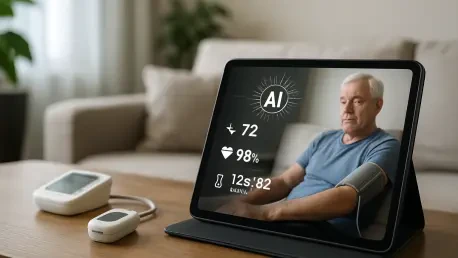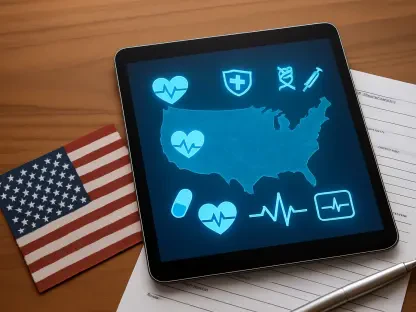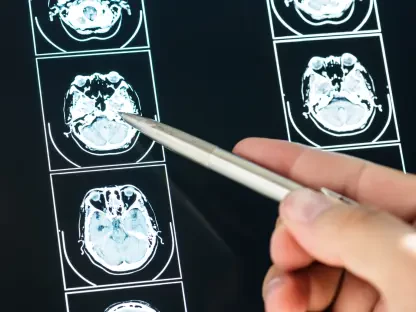Imagine a future where a simple wearable device on your wrist not only tracks your daily steps but also anticipates a medical emergency before any symptoms become apparent, alerting healthcare providers instantly. This is not a distant dream but a tangible reality that Artificial Intelligence (AI) is crafting within the realm of Remote Patient Monitoring (RPM). Valued at USD 1,967.7 million in 2024, the global market for AI in RPM is projected to surge to an astonishing USD 29,225 million by 2035, driven by a compound annual growth rate (CAGR) of 26.3%. This explosive growth signals a profound shift in how healthcare is delivered, moving from reactive treatments to proactive, data-driven interventions. The escalating burden of chronic diseases, coupled with soaring healthcare costs, has created an urgent need for innovative solutions that can monitor patients outside traditional clinical settings. AI stands at the forefront of this transformation, promising to enhance patient outcomes while alleviating economic pressures on healthcare systems. As technology continues to evolve, the integration of AI into RPM is set to redefine the patient-provider relationship, making care more personalized and accessible. This exploration delves into the key drivers, technological advancements, and regional dynamics that will shape this landscape over the next decade, highlighting the potential for a healthier, more connected world.
Harnessing Wearable Technology for Real-Time Health Insights
The proliferation of wearable technology, such as smartwatches and fitness trackers, is a cornerstone of AI’s impact on RPM. With over 1.1 billion connected wearables in use globally as of recent estimates, these devices are already collecting vast amounts of data on vital signs, physical activity, and even sleep patterns. By 2035, AI will elevate the utility of these tools far beyond basic tracking, transforming raw data into predictive insights. Sophisticated algorithms will analyze trends in heart rate, blood oxygen levels, and other metrics to forecast potential health risks, enabling healthcare providers to intervene before issues escalate. This capability will be particularly transformative for individuals with high-risk conditions, ensuring that subtle changes in health status are not overlooked. The seamless connection between wearables and AI systems will create a continuous feedback loop, empowering both patients and clinicians with real-time information that drives better decision-making.
Beyond prediction, AI’s integration with wearable technology will foster a new era of personalized healthcare delivery by 2035. Instead of generic health alerts, patients will receive tailored notifications based on their unique medical history and lifestyle patterns. For instance, a person managing diabetes might get specific warnings about potential blood sugar fluctuations, while someone with a history of cardiac issues could be alerted to irregular heart rhythms. This level of customization will not only improve adherence to treatment plans but also enhance patient engagement in their own care. As wearable devices become more sophisticated and AI algorithms grow more precise, the synergy between these technologies will make proactive health management an everyday norm, reducing the reliance on emergency interventions and reshaping how chronic conditions are addressed remotely.
Addressing the Global Challenge of Chronic Diseases
Chronic diseases represent one of the most pressing challenges in modern healthcare, affecting nearly 45% of the American population and accounting for over 75% of total healthcare expenditure. The ability of AI in RPM to provide continuous monitoring offers a powerful solution to this epidemic, with significant advancements expected by 2035. Through wearable devices and connected systems, AI will track vital health indicators for conditions like diabetes, hypertension, and cardiovascular diseases, identifying early warning signs that might otherwise go unnoticed. This constant vigilance will enable timely interventions, potentially preventing severe complications and reducing the frequency of hospital admissions. For patients living in remote or underserved areas, this technology will bridge critical gaps in access to care, ensuring that geographic barriers do not dictate health outcomes.
The impact of AI on chronic disease management will also extend to improving quality of life for millions by 2035. Beyond merely detecting issues, AI-driven RPM systems will offer actionable recommendations, such as medication reminders or lifestyle adjustments, tailored to individual needs. This approach will empower patients to take an active role in managing their conditions, fostering a sense of control over their health. Additionally, by alleviating the burden on healthcare facilities through remote oversight, these systems will allow medical professionals to focus on complex cases requiring in-person attention. As the global prevalence of chronic conditions continues to rise, particularly among aging populations, the scalability of AI in RPM will be vital in ensuring that healthcare systems can cope with increasing demand without compromising on care quality.
Easing Economic Burdens Through Cost-Effective Care
Healthcare spending has reached unprecedented levels, with the United States alone expending $4.3 trillion in 2021, a figure that underscores the urgent need for cost-effective solutions. By 2035, AI in RPM is expected to play a pivotal role in alleviating these financial pressures by minimizing unnecessary hospitalizations and optimizing resource allocation. Remote monitoring enables patients to receive care from the comfort of their homes, reducing the need for frequent in-person visits and cutting associated costs for both individuals and healthcare systems. This shift is especially significant in the context of post-pandemic recovery, where strained resources have highlighted the value of technologies that maintain continuity of care without overtaxing infrastructure. AI’s ability to prioritize interventions based on data-driven risk assessments will further enhance efficiency in resource use.
Moreover, the economic benefits of AI in RPM will extend to long-term savings for healthcare providers and insurers by 2035. Early detection and prevention of health crises through continuous monitoring can significantly lower the costs associated with emergency treatments and extended hospital stays. For instance, identifying a potential cardiac event before it occurs could save thousands in acute care expenses per patient. This cost-saving potential will encourage wider adoption of RPM solutions across public and private healthcare sectors, creating a ripple effect that benefits entire communities. As economic pressures continue to mount globally, the integration of AI into remote monitoring will serve as a critical tool for balancing high-quality care with fiscal responsibility, ensuring that healthcare remains sustainable in the face of growing challenges.
Driving Progress with AI Innovations
At the heart of RPM’s evolution lies the rapid advancement of AI technologies, particularly machine learning, which already commanded a 34.2% revenue share in the market as of 2022. By 2035, these tools are anticipated to become even more refined, capable of processing enormous datasets to deliver precise diagnostic insights and support clinical decision-making. Machine learning algorithms will continuously learn from patient data, improving their ability to predict outcomes and recommend interventions with unparalleled accuracy. This progress will be complemented by AI-powered diagnostic tools that can analyze medical images or other complex data faster and often more accurately than human clinicians, enabling earlier detection of abnormalities. Such innovations will redefine the standards of remote care delivery over the coming decade.
Another transformative aspect of AI innovation in RPM by 2035 will be its integration into telemedicine platforms, reducing the necessity for physical consultations. Virtual consultations powered by AI will provide personalized care plans based on real-time data, making healthcare more accessible, especially for those in rural or underserved regions. Patients will benefit from immediate feedback and adjustments to their treatment without the delays associated with scheduling in-person visits. This shift will not only enhance patient satisfaction but also streamline workflows for healthcare providers, allowing them to manage larger patient volumes efficiently. As AI continues to evolve, its role in RPM will expand beyond monitoring to become a comprehensive support system for both patients and medical professionals, fundamentally altering the landscape of healthcare delivery.
Navigating Regional Dynamics and Global Expansion
Geographically, North America holds a dominant position in the AI-driven RPM market, with a 45.3% revenue share as of recent data, largely due to its aging population and high prevalence of chronic diseases. However, by 2035, the Asia Pacific region is projected to emerge as the leader in growth, driven by increasing healthcare investments, rapid technological adoption, and a burgeoning patient base. This shift reflects the global nature of healthcare challenges and the varying paces at which regions are embracing AI solutions. In North America, the focus will remain on refining existing systems to enhance efficiency and outcomes, while in Asia Pacific, the emphasis will be on scaling access to RPM technologies to meet the needs of diverse and often underserved populations.
The global expansion of AI in RPM by 2035 will also be shaped by differing healthcare infrastructures and policy environments. In regions with advanced systems, such as Europe, AI will likely focus on integration with existing digital health frameworks to maximize impact. Conversely, in emerging markets, the technology will serve as a foundational tool to leapfrog traditional barriers, providing basic monitoring capabilities where brick-and-mortar facilities are scarce. This disparity highlights the adaptability of AI-driven RPM, which can be tailored to address specific regional needs, whether it’s managing chronic conditions in aging societies or extending basic care in developing areas. The worldwide reach of this technology will ensure that its benefits are not confined to a single demographic or geography, fostering a more equitable approach to global health.
Shaping the Future with Personalized Care
The move toward personalized, patient-centered care is a defining trend in healthcare, with hospitals currently accounting for a 32.8% share of the RPM market. By 2035, AI will solidify this shift, enabling providers to design monitoring and treatment plans that are uniquely suited to individual patients. Data collected through RPM systems will inform customized interventions, ensuring that care is not only reactive but also anticipatory, addressing potential issues before they manifest. This level of personalization will empower patients, giving them greater control over their health journeys and fostering stronger trust in healthcare systems. Hospitals and clinics will increasingly rely on AI to deliver such tailored solutions, enhancing overall patient satisfaction and outcomes.
Furthermore, the emphasis on personalization by 2035 will redefine the role of patients in their own care. AI-driven RPM will provide tools and insights that encourage active participation, such as detailed feedback on health metrics and actionable steps for improvement. For example, a patient recovering from surgery might receive specific guidelines on activity levels based on real-time recovery data, adjusting as healing progresses. This collaborative approach will blur the lines between provider and patient responsibilities, creating a partnership model of care. As AI continues to refine its ability to interpret individual health data, the focus on personalized RPM will become the standard, ensuring that healthcare evolves to meet the unique needs of every person, regardless of their circumstances or location.
Reflecting on a Decade of Transformation
Looking back over the past decade, the journey of AI in Remote Patient Monitoring has proven to be a remarkable testament to technological innovation. What began as a niche concept has matured into a cornerstone of healthcare, with market value soaring from modest beginnings to projections of USD 29,225 million by 2035. The widespread adoption of wearable devices has laid the groundwork, while AI algorithms have sharpened the focus on predictive and personalized care. Challenges like chronic disease prevalence and economic constraints have been met with scalable solutions that redefined patient monitoring. Regional disparities have narrowed as global adoption grew, with each area contributing to a shared vision of accessible health. Moving forward, stakeholders must prioritize investment in AI research and infrastructure to sustain this momentum. Collaboration between tech developers, healthcare providers, and policymakers will be essential to address remaining barriers, such as data privacy and equitable access. By focusing on these actionable steps, the legacy of AI in RPM can continue to evolve, ensuring that the next decade builds on past successes to deliver even greater impact for patients worldwide.









